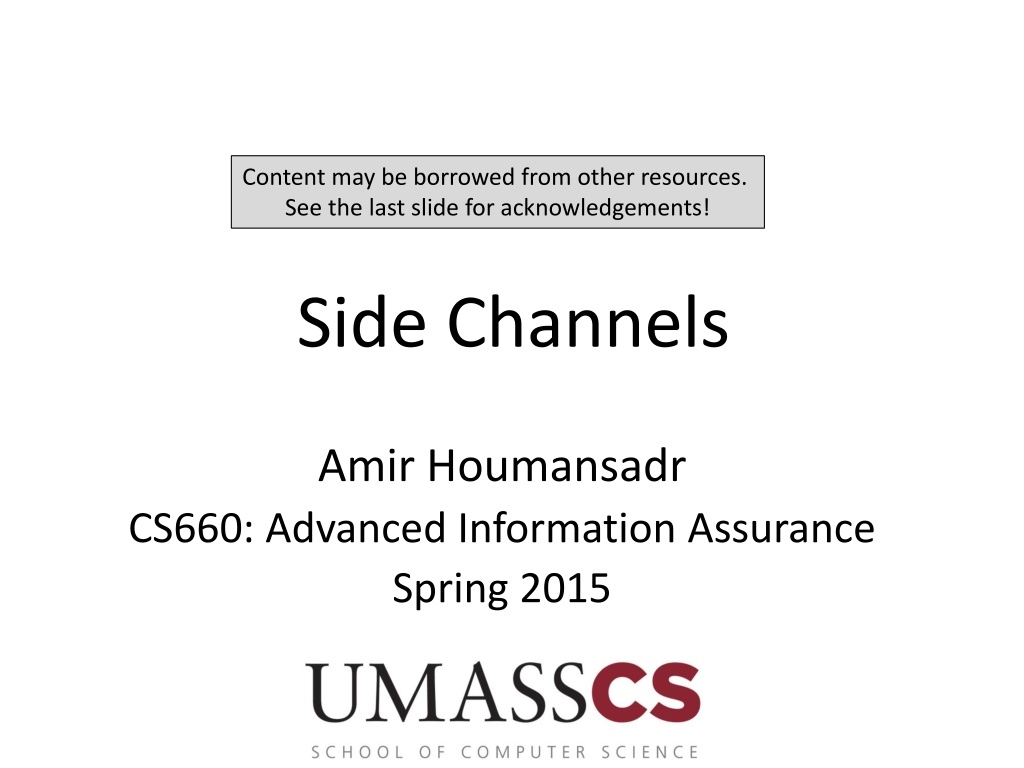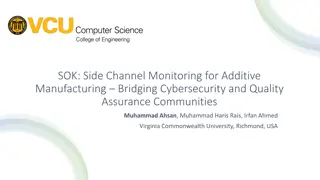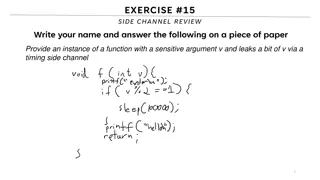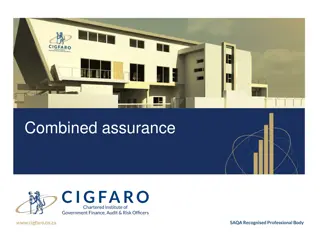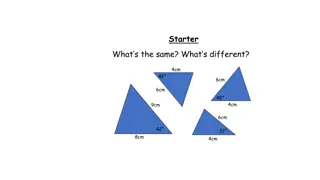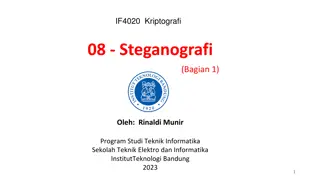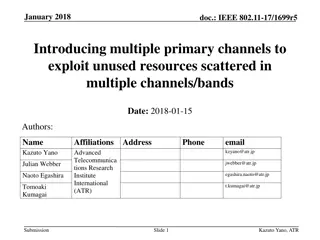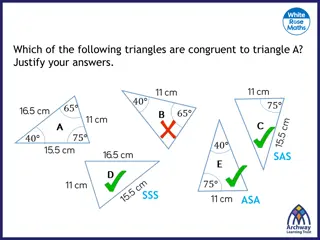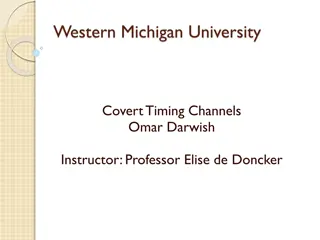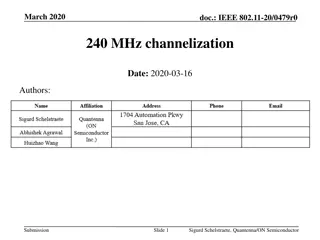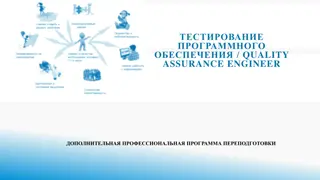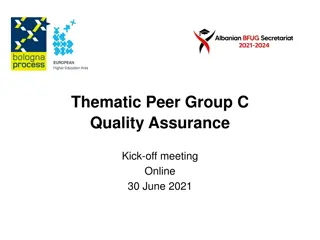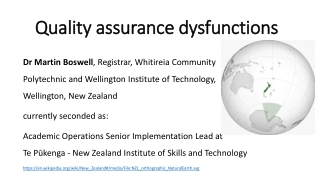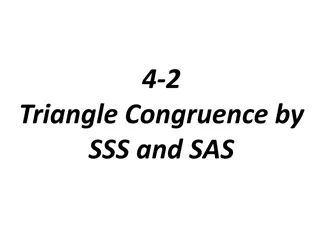Understanding Side Channels and Information Hiding Techniques in Advanced Information Assurance
This content covers various aspects of advanced information assurance, focusing on side channels and information hiding techniques such as digital watermarking, steganography, and covert channels. It discusses the concept of side-channel attacks, types of system and network channels, fault attacks, and timing attacks in cryptographic systems. The importance of understanding these techniques in securing information and communication systems is highlighted throughout the content.
Download Presentation

Please find below an Image/Link to download the presentation.
The content on the website is provided AS IS for your information and personal use only. It may not be sold, licensed, or shared on other websites without obtaining consent from the author. Download presentation by click this link. If you encounter any issues during the download, it is possible that the publisher has removed the file from their server.
E N D
Presentation Transcript
Content may be borrowed from other resources. See the last slide for acknowledgements! Side Channels Amir Houmansadr CS660: Advanced Information Assurance Spring 2015
Classes of Information Hiding Digital watermarking Steganography Covert channels Anonymous communication Protocol obfuscation CS660 - Advanced Information Assurance - UMassAmherst 2
Side Channels A side-channel attack is any attack based on information gained from the physical implementation of a system (process), rather than theoretical weaknesses in the algorithms Similar to covert channels, but information is leaked unintentionally Usually, some shared resource CS660 - Advanced Information Assurance - UMassAmherst 3
Types System (computer) channels Network channels CS660 - Advanced Information Assurance - UMassAmherst 4
System channels Example: crytosystems
Fault Attacks Faults may be unintentional or induced by Heat Cold Low power Microwaves etc. CS660 - Advanced Information Assurance - UMassAmherst 6
Timing Attacks How long does it take to perform a decryption? CS660 - Advanced Information Assurance - UMassAmherst 7
Timing Attacks How long does it take to perform a decryption? The answer may be data-dependent. CS660 - Advanced Information Assurance - UMassAmherst 8
Timing Attacks How long does it take to perform a decryption? The answer may be data-dependent. For instance CS660 - Advanced Information Assurance - UMassAmherst 9
Timing Attacks How long does it take to perform a decryption? The answer may be data-dependent. For instance ? = ?? CS660 - Advanced Information Assurance - UMassAmherst 10
Timing Attacks How long does it take to perform a decryption? The answer may be data-dependent. For instance ? = ?? Watch decryption times for ? = ?(?) where ? < ? and where ? > ?. CS660 - Advanced Information Assurance - UMassAmherst 11
Timing Attacks How long does it take to perform a decryption? The answer may be data-dependent. For instance Watch decryption times for where and where . If there is a minute difference, can be determined with binary search. CS660 - Advanced Information Assurance - UMassAmherst 12
Cache Attacks If you can run code on the same device where a decryption is being performed, you may be able to selectively force certain cache lines to be flushed. Decryption times may vary in a key-dependent manner based upon which lines have been flushed. CS660 - Advanced Information Assurance - UMassAmherst 13
Power Analysis Power usage of a device may vary in a key- dependent manner. CS660 - Advanced Information Assurance - UMassAmherst 14
Power Analysis Power usage of a device may vary in a key- dependent manner. Careful measurement and analysis of power consumption can be used to determine the key. CS660 - Advanced Information Assurance - UMassAmherst 15
Electromagnetic Emissions One can record electromagnetic emissions of a device often at a distance. CS660 - Advanced Information Assurance - UMassAmherst 16
Electromagnetic Emissions One can record electromagnetic emissions of a device often at a distance. Careful analysis of the emissions may reveal a secret key. CS660 - Advanced Information Assurance - UMassAmherst 17
Acoustic Emissions Modular exponentiation is done with repeated squaring and conditional side multiplications. CS660 - Advanced Information Assurance - UMassAmherst 18
Acoustic Emissions Modular exponentiation is done with repeated squaring and conditional side multiplications. It can actually be possible to hear whether or not these conditional multiplications are performed. CS660 - Advanced Information Assurance - UMassAmherst 19
Information Disclosures (N.B. Bleichenbacher Attack) A protocol may respond differently to properly and improperly formed data. CS660 - Advanced Information Assurance - UMassAmherst 20
Information Disclosures (N.B. Bleichenbacher Attack) A protocol may respond differently to properly and improperly formed data. Careful manipulation of data may elicit responses which disclose information about a desired key or decryption value. CS660 - Advanced Information Assurance - UMassAmherst 21
Types Passive Active CS660 - Advanced Information Assurance - UMassAmherst 22
System Side-Channel Attacks Examples: Fault Attacks Timing Attacks Cache Attacks Power Analysis Electromagnetic Emissions Acoustic Emissions Information Disclosure CS660 - Advanced Information Assurance - UMassAmherst 23
Acknowledgement Some of the slides, content, or pictures are borrowed from the following resources, and some pictures are obtained through Google search without being referenced below: Josh Benaloh and Brian LaMacchia, Practical Aspects of Modern Cryptography, Winter 2011. CS660 - Advanced Information Assurance - UMassAmherst 24
